Change Management: Lean Six Sigma at Fonterra, New Zealand
VerifiedAdded on 2022/12/30
|9
|2240
|27
Report
AI Summary
This report provides a comprehensive analysis of change management, focusing on the implementation of Lean Six Sigma principles within Fonterra, a prominent dairy company in New Zealand. The report highlights the importance of customer focus, value stream mapping, process optimization, product testing, effective communication, and organizational culture in successful Lean Six Sigma implementation. It then critically examines the challenges encountered by two other companies, Tip Top and Anchor, during their Lean Six Sigma adoption, including resistance to change, lack of resources, insufficient information, and inadequate leadership commitment. The report concludes with practical recommendations for overcoming these challenges, emphasizing the importance of leadership involvement, thorough market research, employee training, and reward systems to foster a culture of continuous improvement and achieve desired business outcomes. The report emphasizes the need for effective communication, employee involvement, and a supportive organizational culture to facilitate successful change management initiatives. The report provides valuable insights for businesses seeking to improve their operational efficiency and customer satisfaction through Lean Six Sigma.

Running head: CHANGE MANAGEMENT
CHANGE MANAGEMENT
Name of the Student:
Name of the University:
Author note:
CHANGE MANAGEMENT
Name of the Student:
Name of the University:
Author note:
Paraphrase This Document
Need a fresh take? Get an instant paraphrase of this document with our AI Paraphraser
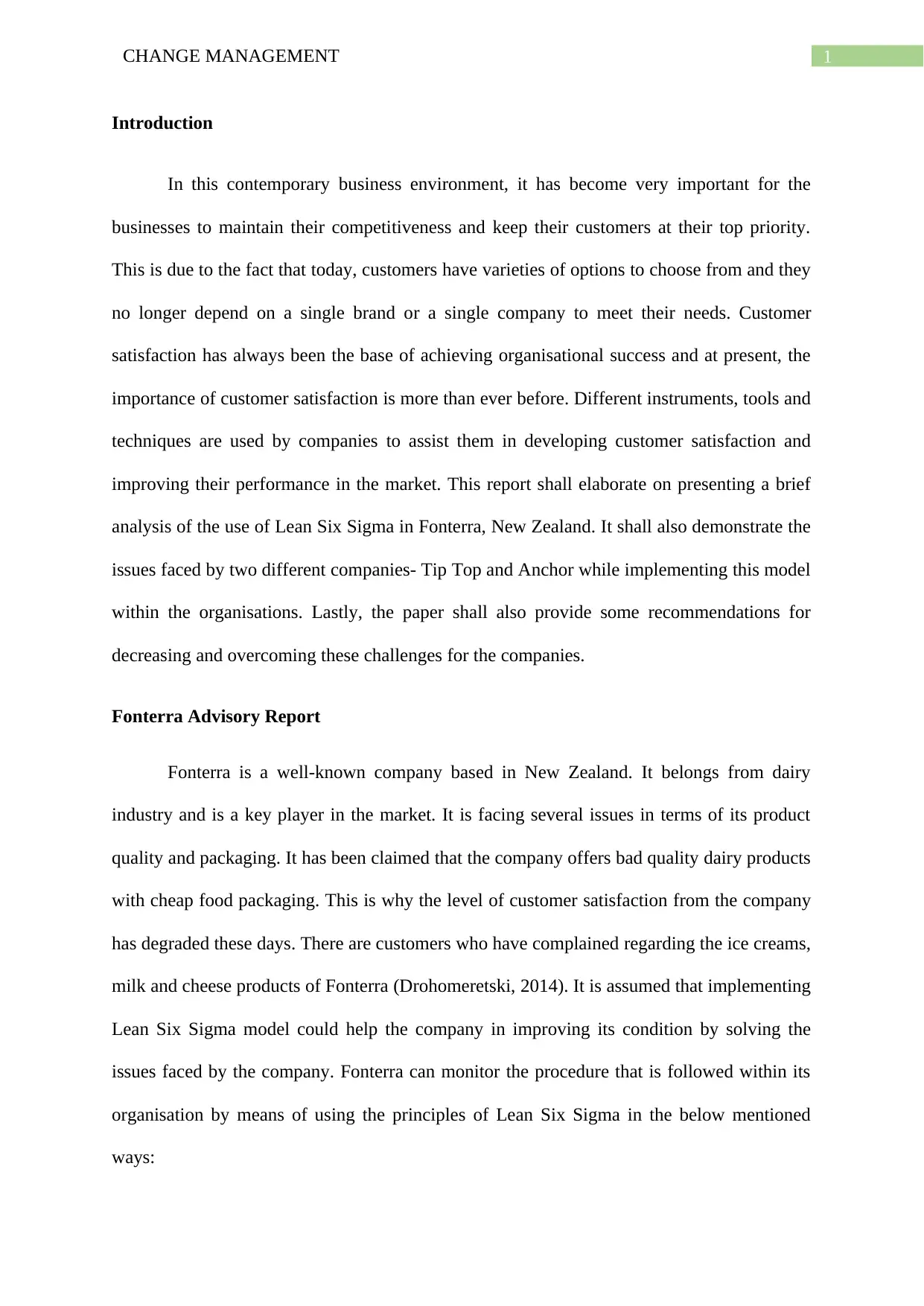
1CHANGE MANAGEMENT
Introduction
In this contemporary business environment, it has become very important for the
businesses to maintain their competitiveness and keep their customers at their top priority.
This is due to the fact that today, customers have varieties of options to choose from and they
no longer depend on a single brand or a single company to meet their needs. Customer
satisfaction has always been the base of achieving organisational success and at present, the
importance of customer satisfaction is more than ever before. Different instruments, tools and
techniques are used by companies to assist them in developing customer satisfaction and
improving their performance in the market. This report shall elaborate on presenting a brief
analysis of the use of Lean Six Sigma in Fonterra, New Zealand. It shall also demonstrate the
issues faced by two different companies- Tip Top and Anchor while implementing this model
within the organisations. Lastly, the paper shall also provide some recommendations for
decreasing and overcoming these challenges for the companies.
Fonterra Advisory Report
Fonterra is a well-known company based in New Zealand. It belongs from dairy
industry and is a key player in the market. It is facing several issues in terms of its product
quality and packaging. It has been claimed that the company offers bad quality dairy products
with cheap food packaging. This is why the level of customer satisfaction from the company
has degraded these days. There are customers who have complained regarding the ice creams,
milk and cheese products of Fonterra (Drohomeretski, 2014). It is assumed that implementing
Lean Six Sigma model could help the company in improving its condition by solving the
issues faced by the company. Fonterra can monitor the procedure that is followed within its
organisation by means of using the principles of Lean Six Sigma in the below mentioned
ways:
Introduction
In this contemporary business environment, it has become very important for the
businesses to maintain their competitiveness and keep their customers at their top priority.
This is due to the fact that today, customers have varieties of options to choose from and they
no longer depend on a single brand or a single company to meet their needs. Customer
satisfaction has always been the base of achieving organisational success and at present, the
importance of customer satisfaction is more than ever before. Different instruments, tools and
techniques are used by companies to assist them in developing customer satisfaction and
improving their performance in the market. This report shall elaborate on presenting a brief
analysis of the use of Lean Six Sigma in Fonterra, New Zealand. It shall also demonstrate the
issues faced by two different companies- Tip Top and Anchor while implementing this model
within the organisations. Lastly, the paper shall also provide some recommendations for
decreasing and overcoming these challenges for the companies.
Fonterra Advisory Report
Fonterra is a well-known company based in New Zealand. It belongs from dairy
industry and is a key player in the market. It is facing several issues in terms of its product
quality and packaging. It has been claimed that the company offers bad quality dairy products
with cheap food packaging. This is why the level of customer satisfaction from the company
has degraded these days. There are customers who have complained regarding the ice creams,
milk and cheese products of Fonterra (Drohomeretski, 2014). It is assumed that implementing
Lean Six Sigma model could help the company in improving its condition by solving the
issues faced by the company. Fonterra can monitor the procedure that is followed within its
organisation by means of using the principles of Lean Six Sigma in the below mentioned
ways:
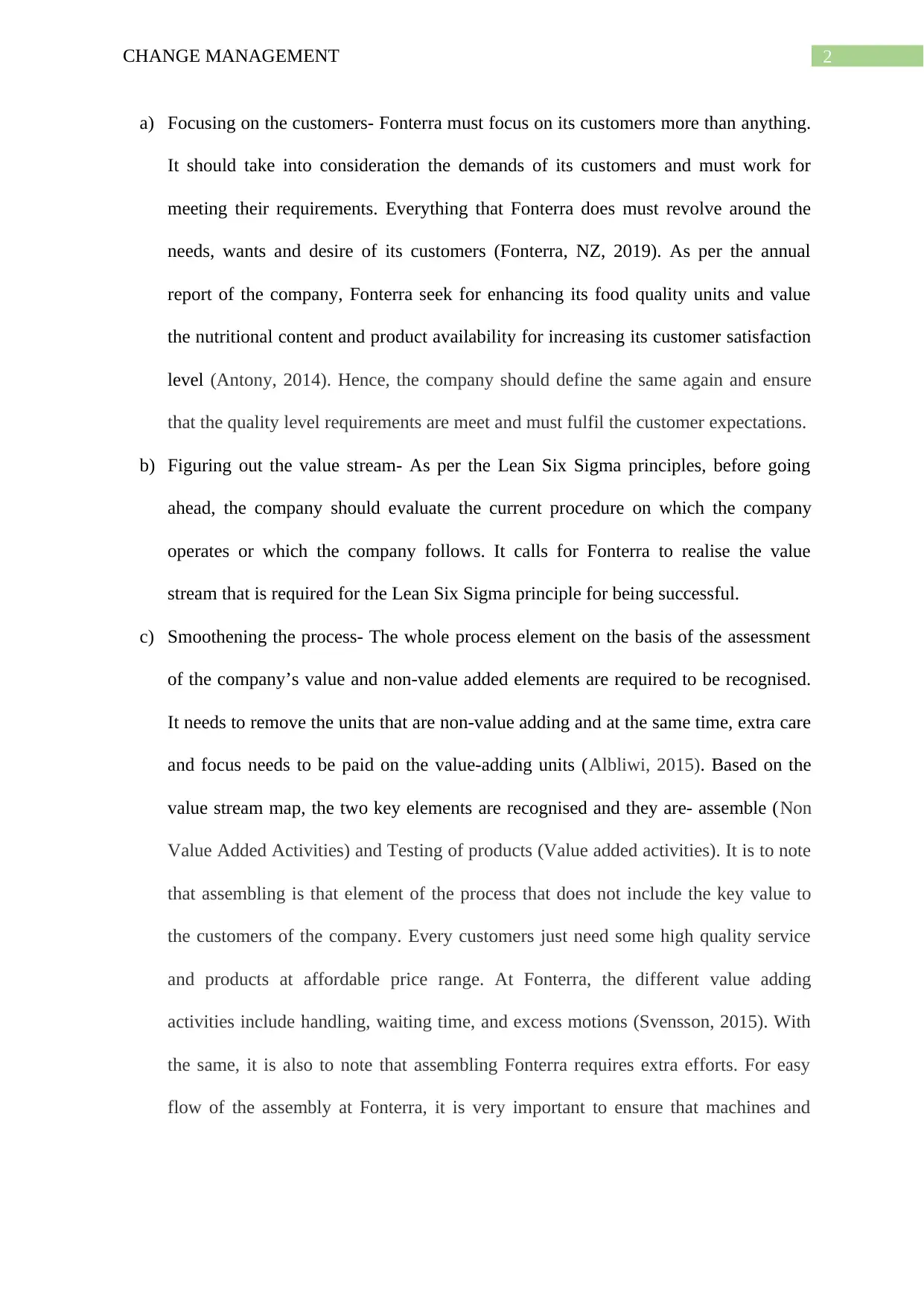
2CHANGE MANAGEMENT
a) Focusing on the customers- Fonterra must focus on its customers more than anything.
It should take into consideration the demands of its customers and must work for
meeting their requirements. Everything that Fonterra does must revolve around the
needs, wants and desire of its customers (Fonterra, NZ, 2019). As per the annual
report of the company, Fonterra seek for enhancing its food quality units and value
the nutritional content and product availability for increasing its customer satisfaction
level (Antony, 2014). Hence, the company should define the same again and ensure
that the quality level requirements are meet and must fulfil the customer expectations.
b) Figuring out the value stream- As per the Lean Six Sigma principles, before going
ahead, the company should evaluate the current procedure on which the company
operates or which the company follows. It calls for Fonterra to realise the value
stream that is required for the Lean Six Sigma principle for being successful.
c) Smoothening the process- The whole process element on the basis of the assessment
of the company’s value and non-value added elements are required to be recognised.
It needs to remove the units that are non-value adding and at the same time, extra care
and focus needs to be paid on the value-adding units (Albliwi, 2015). Based on the
value stream map, the two key elements are recognised and they are- assemble (Non
Value Added Activities) and Testing of products (Value added activities). It is to note
that assembling is that element of the process that does not include the key value to
the customers of the company. Every customers just need some high quality service
and products at affordable price range. At Fonterra, the different value adding
activities include handling, waiting time, and excess motions (Svensson, 2015). With
the same, it is also to note that assembling Fonterra requires extra efforts. For easy
flow of the assembly at Fonterra, it is very important to ensure that machines and
a) Focusing on the customers- Fonterra must focus on its customers more than anything.
It should take into consideration the demands of its customers and must work for
meeting their requirements. Everything that Fonterra does must revolve around the
needs, wants and desire of its customers (Fonterra, NZ, 2019). As per the annual
report of the company, Fonterra seek for enhancing its food quality units and value
the nutritional content and product availability for increasing its customer satisfaction
level (Antony, 2014). Hence, the company should define the same again and ensure
that the quality level requirements are meet and must fulfil the customer expectations.
b) Figuring out the value stream- As per the Lean Six Sigma principles, before going
ahead, the company should evaluate the current procedure on which the company
operates or which the company follows. It calls for Fonterra to realise the value
stream that is required for the Lean Six Sigma principle for being successful.
c) Smoothening the process- The whole process element on the basis of the assessment
of the company’s value and non-value added elements are required to be recognised.
It needs to remove the units that are non-value adding and at the same time, extra care
and focus needs to be paid on the value-adding units (Albliwi, 2015). Based on the
value stream map, the two key elements are recognised and they are- assemble (Non
Value Added Activities) and Testing of products (Value added activities). It is to note
that assembling is that element of the process that does not include the key value to
the customers of the company. Every customers just need some high quality service
and products at affordable price range. At Fonterra, the different value adding
activities include handling, waiting time, and excess motions (Svensson, 2015). With
the same, it is also to note that assembling Fonterra requires extra efforts. For easy
flow of the assembly at Fonterra, it is very important to ensure that machines and
⊘ This is a preview!⊘
Do you want full access?
Subscribe today to unlock all pages.

Trusted by 1+ million students worldwide
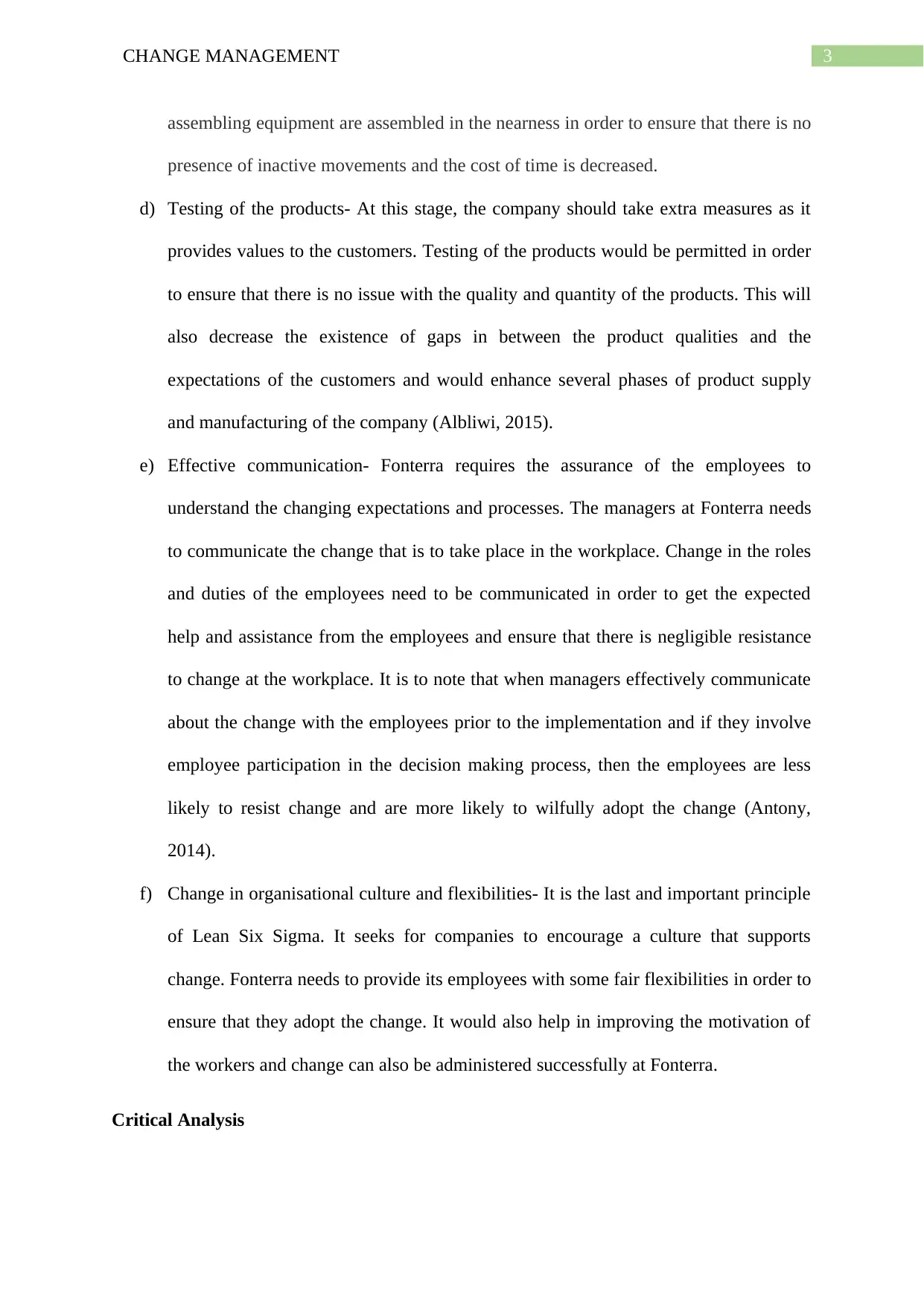
3CHANGE MANAGEMENT
assembling equipment are assembled in the nearness in order to ensure that there is no
presence of inactive movements and the cost of time is decreased.
d) Testing of the products- At this stage, the company should take extra measures as it
provides values to the customers. Testing of the products would be permitted in order
to ensure that there is no issue with the quality and quantity of the products. This will
also decrease the existence of gaps in between the product qualities and the
expectations of the customers and would enhance several phases of product supply
and manufacturing of the company (Albliwi, 2015).
e) Effective communication- Fonterra requires the assurance of the employees to
understand the changing expectations and processes. The managers at Fonterra needs
to communicate the change that is to take place in the workplace. Change in the roles
and duties of the employees need to be communicated in order to get the expected
help and assistance from the employees and ensure that there is negligible resistance
to change at the workplace. It is to note that when managers effectively communicate
about the change with the employees prior to the implementation and if they involve
employee participation in the decision making process, then the employees are less
likely to resist change and are more likely to wilfully adopt the change (Antony,
2014).
f) Change in organisational culture and flexibilities- It is the last and important principle
of Lean Six Sigma. It seeks for companies to encourage a culture that supports
change. Fonterra needs to provide its employees with some fair flexibilities in order to
ensure that they adopt the change. It would also help in improving the motivation of
the workers and change can also be administered successfully at Fonterra.
Critical Analysis
assembling equipment are assembled in the nearness in order to ensure that there is no
presence of inactive movements and the cost of time is decreased.
d) Testing of the products- At this stage, the company should take extra measures as it
provides values to the customers. Testing of the products would be permitted in order
to ensure that there is no issue with the quality and quantity of the products. This will
also decrease the existence of gaps in between the product qualities and the
expectations of the customers and would enhance several phases of product supply
and manufacturing of the company (Albliwi, 2015).
e) Effective communication- Fonterra requires the assurance of the employees to
understand the changing expectations and processes. The managers at Fonterra needs
to communicate the change that is to take place in the workplace. Change in the roles
and duties of the employees need to be communicated in order to get the expected
help and assistance from the employees and ensure that there is negligible resistance
to change at the workplace. It is to note that when managers effectively communicate
about the change with the employees prior to the implementation and if they involve
employee participation in the decision making process, then the employees are less
likely to resist change and are more likely to wilfully adopt the change (Antony,
2014).
f) Change in organisational culture and flexibilities- It is the last and important principle
of Lean Six Sigma. It seeks for companies to encourage a culture that supports
change. Fonterra needs to provide its employees with some fair flexibilities in order to
ensure that they adopt the change. It would also help in improving the motivation of
the workers and change can also be administered successfully at Fonterra.
Critical Analysis
Paraphrase This Document
Need a fresh take? Get an instant paraphrase of this document with our AI Paraphraser
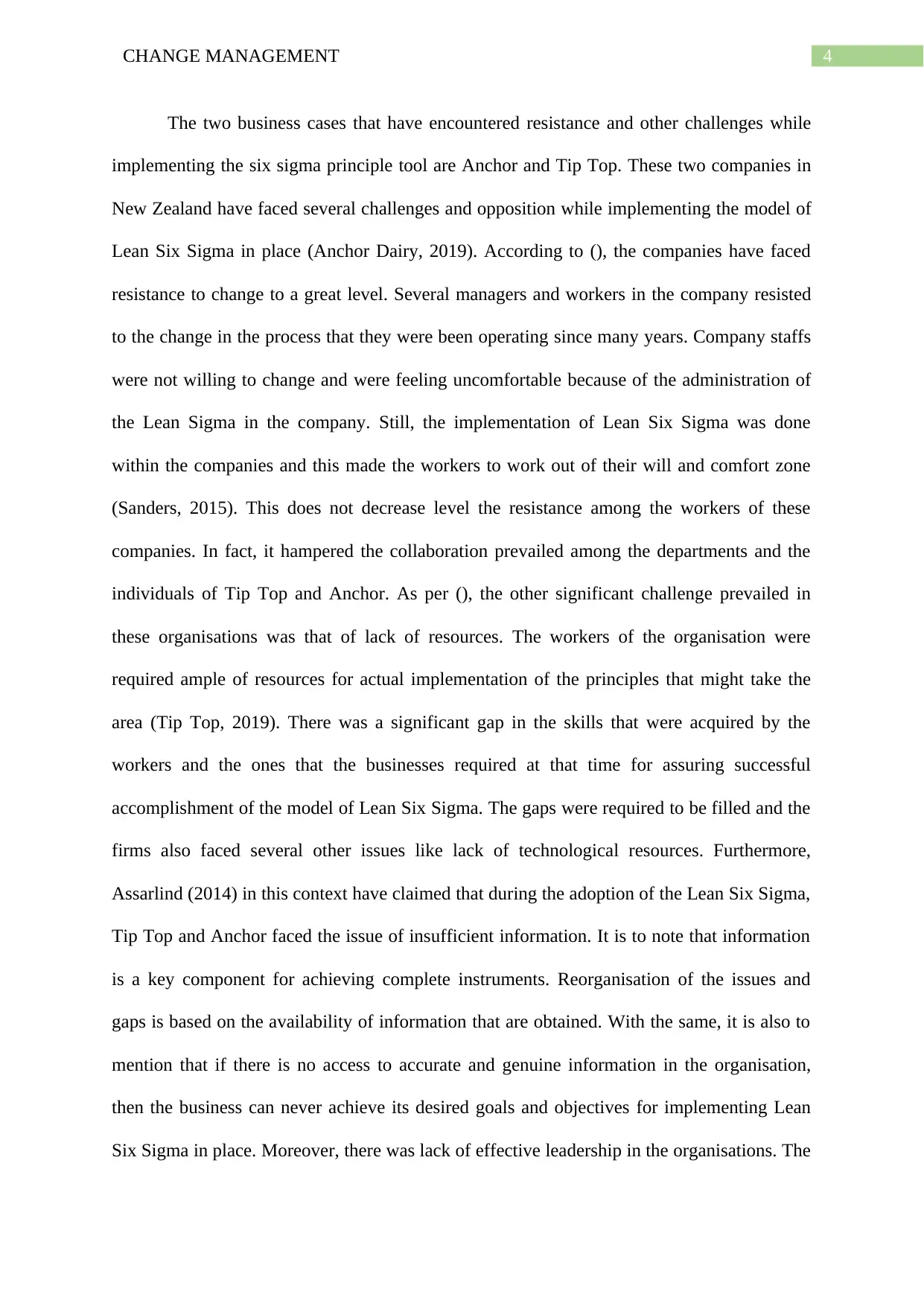
4CHANGE MANAGEMENT
The two business cases that have encountered resistance and other challenges while
implementing the six sigma principle tool are Anchor and Tip Top. These two companies in
New Zealand have faced several challenges and opposition while implementing the model of
Lean Six Sigma in place (Anchor Dairy, 2019). According to (), the companies have faced
resistance to change to a great level. Several managers and workers in the company resisted
to the change in the process that they were been operating since many years. Company staffs
were not willing to change and were feeling uncomfortable because of the administration of
the Lean Sigma in the company. Still, the implementation of Lean Six Sigma was done
within the companies and this made the workers to work out of their will and comfort zone
(Sanders, 2015). This does not decrease level the resistance among the workers of these
companies. In fact, it hampered the collaboration prevailed among the departments and the
individuals of Tip Top and Anchor. As per (), the other significant challenge prevailed in
these organisations was that of lack of resources. The workers of the organisation were
required ample of resources for actual implementation of the principles that might take the
area (Tip Top, 2019). There was a significant gap in the skills that were acquired by the
workers and the ones that the businesses required at that time for assuring successful
accomplishment of the model of Lean Six Sigma. The gaps were required to be filled and the
firms also faced several other issues like lack of technological resources. Furthermore,
Assarlind (2014) in this context have claimed that during the adoption of the Lean Six Sigma,
Tip Top and Anchor faced the issue of insufficient information. It is to note that information
is a key component for achieving complete instruments. Reorganisation of the issues and
gaps is based on the availability of information that are obtained. With the same, it is also to
mention that if there is no access to accurate and genuine information in the organisation,
then the business can never achieve its desired goals and objectives for implementing Lean
Six Sigma in place. Moreover, there was lack of effective leadership in the organisations. The
The two business cases that have encountered resistance and other challenges while
implementing the six sigma principle tool are Anchor and Tip Top. These two companies in
New Zealand have faced several challenges and opposition while implementing the model of
Lean Six Sigma in place (Anchor Dairy, 2019). According to (), the companies have faced
resistance to change to a great level. Several managers and workers in the company resisted
to the change in the process that they were been operating since many years. Company staffs
were not willing to change and were feeling uncomfortable because of the administration of
the Lean Sigma in the company. Still, the implementation of Lean Six Sigma was done
within the companies and this made the workers to work out of their will and comfort zone
(Sanders, 2015). This does not decrease level the resistance among the workers of these
companies. In fact, it hampered the collaboration prevailed among the departments and the
individuals of Tip Top and Anchor. As per (), the other significant challenge prevailed in
these organisations was that of lack of resources. The workers of the organisation were
required ample of resources for actual implementation of the principles that might take the
area (Tip Top, 2019). There was a significant gap in the skills that were acquired by the
workers and the ones that the businesses required at that time for assuring successful
accomplishment of the model of Lean Six Sigma. The gaps were required to be filled and the
firms also faced several other issues like lack of technological resources. Furthermore,
Assarlind (2014) in this context have claimed that during the adoption of the Lean Six Sigma,
Tip Top and Anchor faced the issue of insufficient information. It is to note that information
is a key component for achieving complete instruments. Reorganisation of the issues and
gaps is based on the availability of information that are obtained. With the same, it is also to
mention that if there is no access to accurate and genuine information in the organisation,
then the business can never achieve its desired goals and objectives for implementing Lean
Six Sigma in place. Moreover, there was lack of effective leadership in the organisations. The
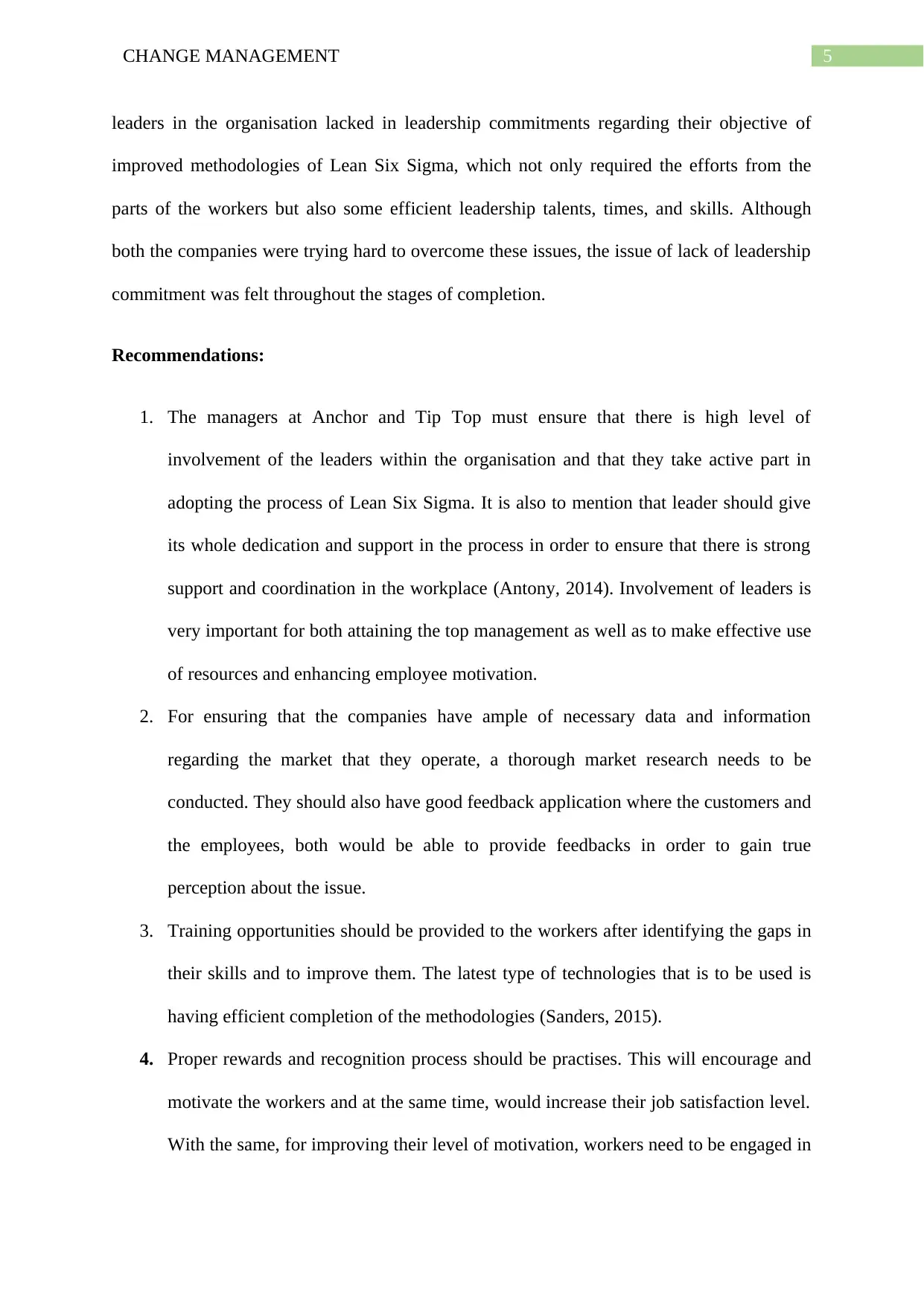
5CHANGE MANAGEMENT
leaders in the organisation lacked in leadership commitments regarding their objective of
improved methodologies of Lean Six Sigma, which not only required the efforts from the
parts of the workers but also some efficient leadership talents, times, and skills. Although
both the companies were trying hard to overcome these issues, the issue of lack of leadership
commitment was felt throughout the stages of completion.
Recommendations:
1. The managers at Anchor and Tip Top must ensure that there is high level of
involvement of the leaders within the organisation and that they take active part in
adopting the process of Lean Six Sigma. It is also to mention that leader should give
its whole dedication and support in the process in order to ensure that there is strong
support and coordination in the workplace (Antony, 2014). Involvement of leaders is
very important for both attaining the top management as well as to make effective use
of resources and enhancing employee motivation.
2. For ensuring that the companies have ample of necessary data and information
regarding the market that they operate, a thorough market research needs to be
conducted. They should also have good feedback application where the customers and
the employees, both would be able to provide feedbacks in order to gain true
perception about the issue.
3. Training opportunities should be provided to the workers after identifying the gaps in
their skills and to improve them. The latest type of technologies that is to be used is
having efficient completion of the methodologies (Sanders, 2015).
4. Proper rewards and recognition process should be practises. This will encourage and
motivate the workers and at the same time, would increase their job satisfaction level.
With the same, for improving their level of motivation, workers need to be engaged in
leaders in the organisation lacked in leadership commitments regarding their objective of
improved methodologies of Lean Six Sigma, which not only required the efforts from the
parts of the workers but also some efficient leadership talents, times, and skills. Although
both the companies were trying hard to overcome these issues, the issue of lack of leadership
commitment was felt throughout the stages of completion.
Recommendations:
1. The managers at Anchor and Tip Top must ensure that there is high level of
involvement of the leaders within the organisation and that they take active part in
adopting the process of Lean Six Sigma. It is also to mention that leader should give
its whole dedication and support in the process in order to ensure that there is strong
support and coordination in the workplace (Antony, 2014). Involvement of leaders is
very important for both attaining the top management as well as to make effective use
of resources and enhancing employee motivation.
2. For ensuring that the companies have ample of necessary data and information
regarding the market that they operate, a thorough market research needs to be
conducted. They should also have good feedback application where the customers and
the employees, both would be able to provide feedbacks in order to gain true
perception about the issue.
3. Training opportunities should be provided to the workers after identifying the gaps in
their skills and to improve them. The latest type of technologies that is to be used is
having efficient completion of the methodologies (Sanders, 2015).
4. Proper rewards and recognition process should be practises. This will encourage and
motivate the workers and at the same time, would increase their job satisfaction level.
With the same, for improving their level of motivation, workers need to be engaged in
⊘ This is a preview!⊘
Do you want full access?
Subscribe today to unlock all pages.

Trusted by 1+ million students worldwide
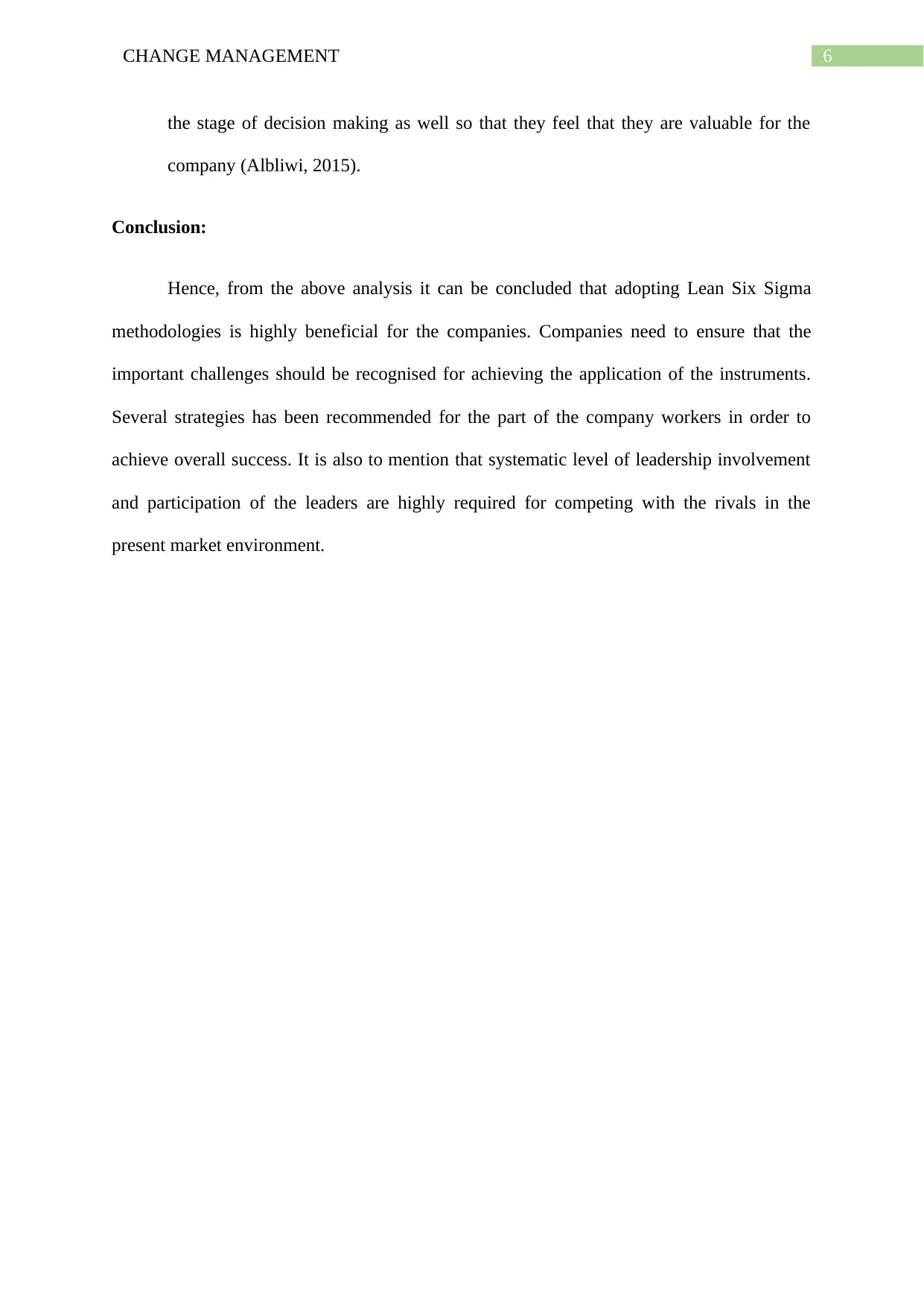
6CHANGE MANAGEMENT
the stage of decision making as well so that they feel that they are valuable for the
company (Albliwi, 2015).
Conclusion:
Hence, from the above analysis it can be concluded that adopting Lean Six Sigma
methodologies is highly beneficial for the companies. Companies need to ensure that the
important challenges should be recognised for achieving the application of the instruments.
Several strategies has been recommended for the part of the company workers in order to
achieve overall success. It is also to mention that systematic level of leadership involvement
and participation of the leaders are highly required for competing with the rivals in the
present market environment.
the stage of decision making as well so that they feel that they are valuable for the
company (Albliwi, 2015).
Conclusion:
Hence, from the above analysis it can be concluded that adopting Lean Six Sigma
methodologies is highly beneficial for the companies. Companies need to ensure that the
important challenges should be recognised for achieving the application of the instruments.
Several strategies has been recommended for the part of the company workers in order to
achieve overall success. It is also to mention that systematic level of leadership involvement
and participation of the leaders are highly required for competing with the rivals in the
present market environment.
Paraphrase This Document
Need a fresh take? Get an instant paraphrase of this document with our AI Paraphraser
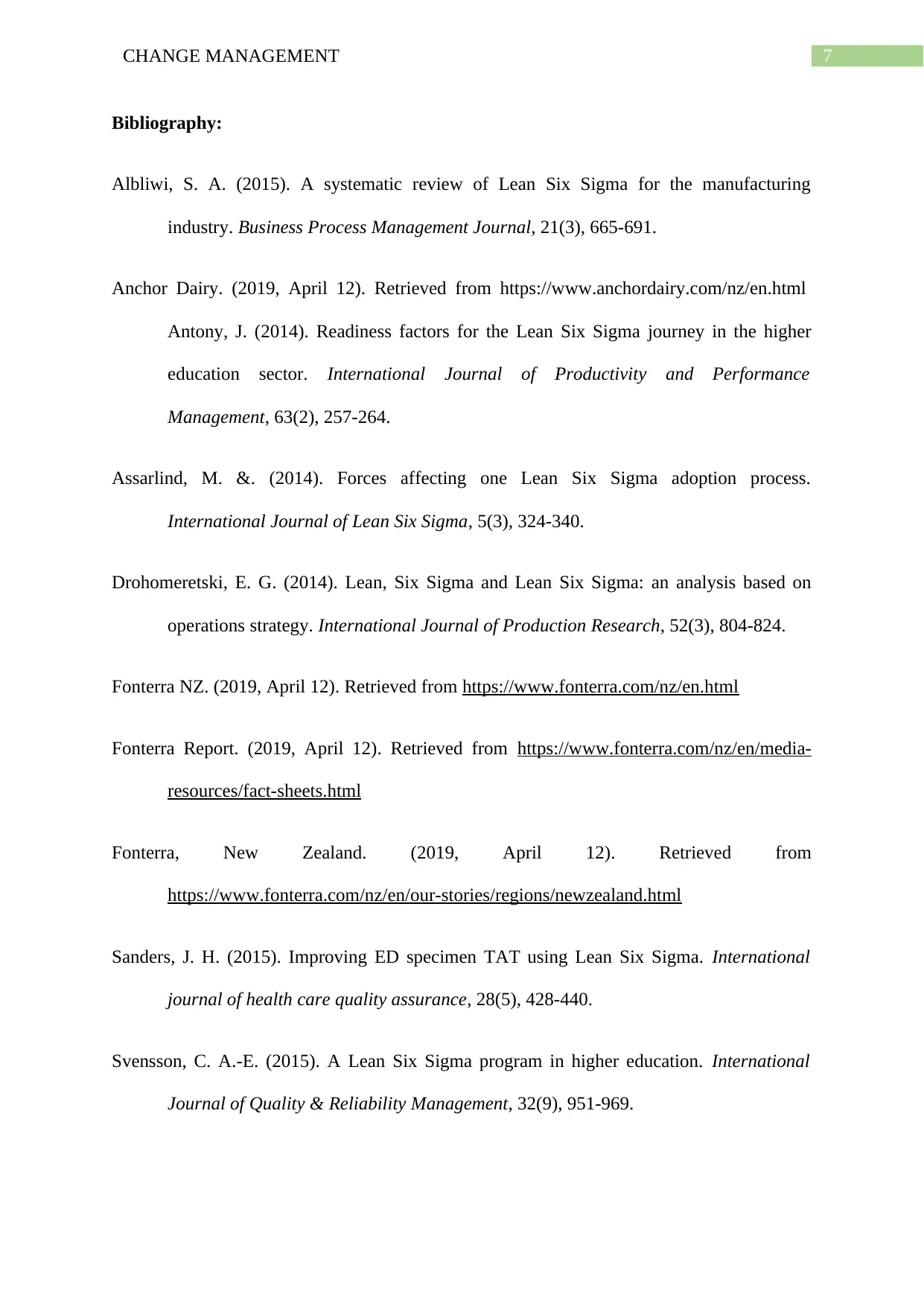
7CHANGE MANAGEMENT
Bibliography:
Albliwi, S. A. (2015). A systematic review of Lean Six Sigma for the manufacturing
industry. Business Process Management Journal, 21(3), 665-691.
Anchor Dairy. (2019, April 12). Retrieved from https://www.anchordairy.com/nz/en.html
Antony, J. (2014). Readiness factors for the Lean Six Sigma journey in the higher
education sector. International Journal of Productivity and Performance
Management, 63(2), 257-264.
Assarlind, M. &. (2014). Forces affecting one Lean Six Sigma adoption process.
International Journal of Lean Six Sigma, 5(3), 324-340.
Drohomeretski, E. G. (2014). Lean, Six Sigma and Lean Six Sigma: an analysis based on
operations strategy. International Journal of Production Research, 52(3), 804-824.
Fonterra NZ. (2019, April 12). Retrieved from https://www.fonterra.com/nz/en.html
Fonterra Report. (2019, April 12). Retrieved from https://www.fonterra.com/nz/en/media-
resources/fact-sheets.html
Fonterra, New Zealand. (2019, April 12). Retrieved from
https://www.fonterra.com/nz/en/our-stories/regions/newzealand.html
Sanders, J. H. (2015). Improving ED specimen TAT using Lean Six Sigma. International
journal of health care quality assurance, 28(5), 428-440.
Svensson, C. A.-E. (2015). A Lean Six Sigma program in higher education. International
Journal of Quality & Reliability Management, 32(9), 951-969.
Bibliography:
Albliwi, S. A. (2015). A systematic review of Lean Six Sigma for the manufacturing
industry. Business Process Management Journal, 21(3), 665-691.
Anchor Dairy. (2019, April 12). Retrieved from https://www.anchordairy.com/nz/en.html
Antony, J. (2014). Readiness factors for the Lean Six Sigma journey in the higher
education sector. International Journal of Productivity and Performance
Management, 63(2), 257-264.
Assarlind, M. &. (2014). Forces affecting one Lean Six Sigma adoption process.
International Journal of Lean Six Sigma, 5(3), 324-340.
Drohomeretski, E. G. (2014). Lean, Six Sigma and Lean Six Sigma: an analysis based on
operations strategy. International Journal of Production Research, 52(3), 804-824.
Fonterra NZ. (2019, April 12). Retrieved from https://www.fonterra.com/nz/en.html
Fonterra Report. (2019, April 12). Retrieved from https://www.fonterra.com/nz/en/media-
resources/fact-sheets.html
Fonterra, New Zealand. (2019, April 12). Retrieved from
https://www.fonterra.com/nz/en/our-stories/regions/newzealand.html
Sanders, J. H. (2015). Improving ED specimen TAT using Lean Six Sigma. International
journal of health care quality assurance, 28(5), 428-440.
Svensson, C. A.-E. (2015). A Lean Six Sigma program in higher education. International
Journal of Quality & Reliability Management, 32(9), 951-969.
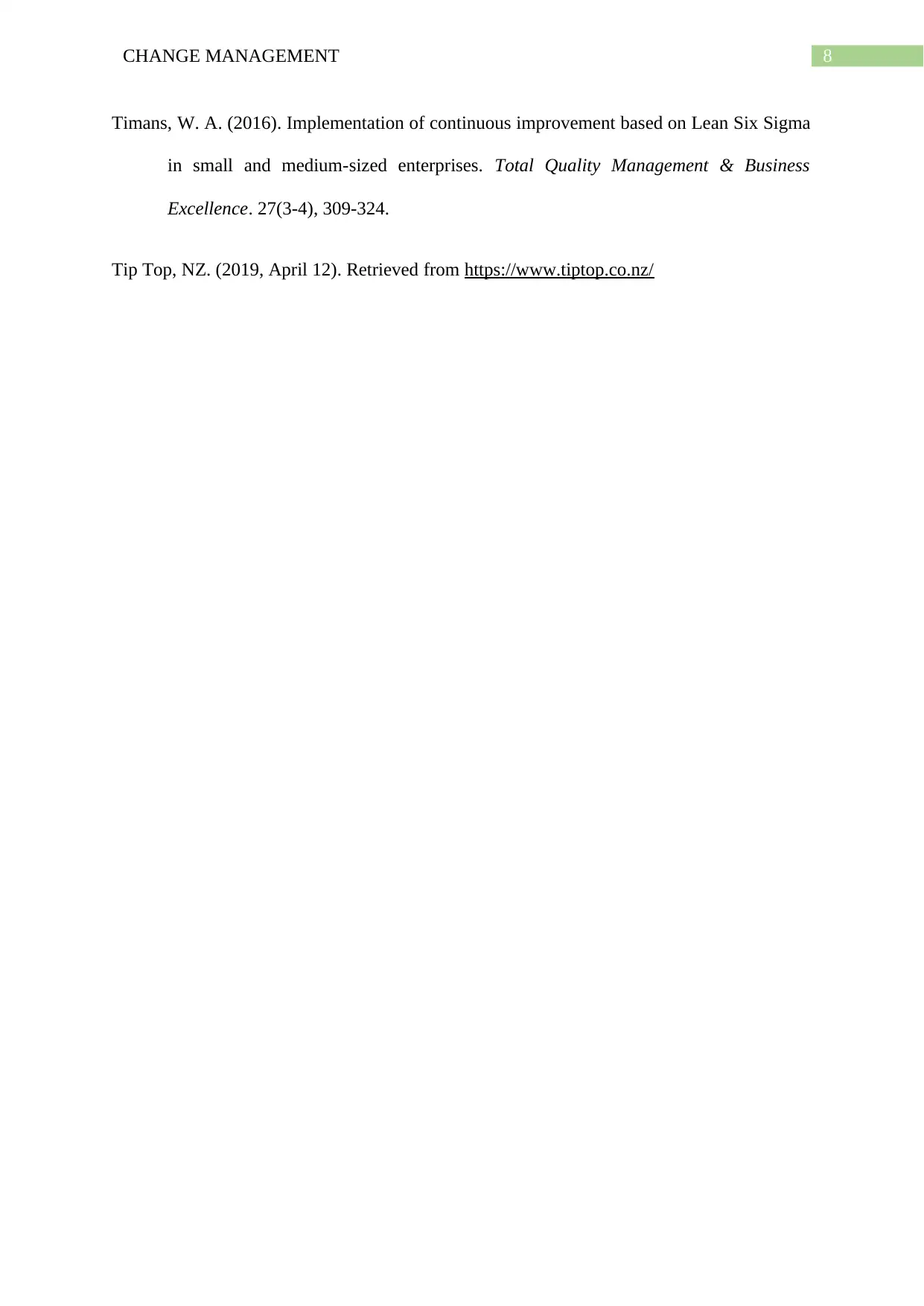
8CHANGE MANAGEMENT
Timans, W. A. (2016). Implementation of continuous improvement based on Lean Six Sigma
in small and medium-sized enterprises. Total Quality Management & Business
Excellence. 27(3-4), 309-324.
Tip Top, NZ. (2019, April 12). Retrieved from https://www.tiptop.co.nz/
Timans, W. A. (2016). Implementation of continuous improvement based on Lean Six Sigma
in small and medium-sized enterprises. Total Quality Management & Business
Excellence. 27(3-4), 309-324.
Tip Top, NZ. (2019, April 12). Retrieved from https://www.tiptop.co.nz/
⊘ This is a preview!⊘
Do you want full access?
Subscribe today to unlock all pages.

Trusted by 1+ million students worldwide
1 out of 9
Related Documents
Your All-in-One AI-Powered Toolkit for Academic Success.
+13062052269
info@desklib.com
Available 24*7 on WhatsApp / Email
![[object Object]](/_next/static/media/star-bottom.7253800d.svg)
Unlock your academic potential
Copyright © 2020–2025 A2Z Services. All Rights Reserved. Developed and managed by ZUCOL.





